For any global traveler, a regular, reliable Internet connection is essential for planning and navigating your trip. Japan's spotty public Wi-Fi, however, has thwarted plenty of tourists from reading their email or visiting their favorite website. But fear not! Your pals here at said favorite website Tofugu have put together our list of Wi-Fi options—many of them reviewed by our own staff—to improve your connectivity, and smooth your travels. From the most reliable free hotspots to an array of paid and portable options, we've got you covered and have the personal experience to back it up.
In this article, we'll be talking about a plethora of ways to get connected:
- Free Public Wi-Fi Hotspots
- Other Public Hotspot Options
- Pocket Wi-Fi We've Tried
- Other Pocket Wi-Fi Options
- Using Your Phone in Japan
- Logging Out
We'll also be updating this list as often as we can, so bookmark it, and check back before your next adventure! Ready to log in?
Free Public Wi-Fi Hotspots
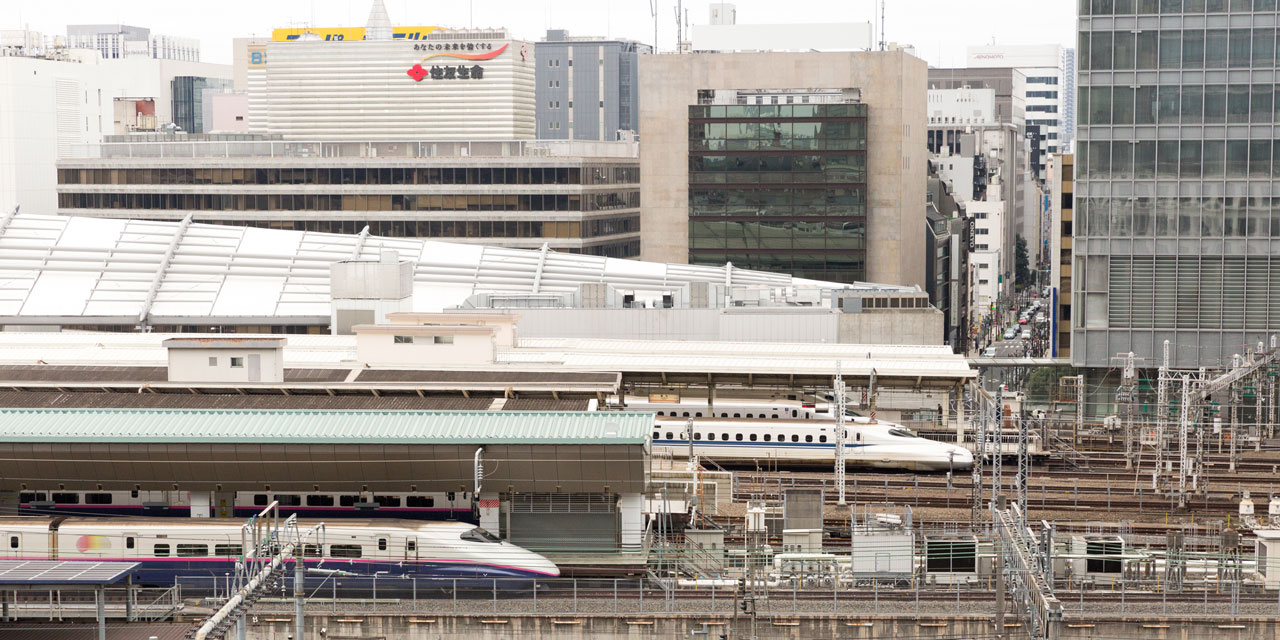
Even though free, fast Wi-Fi may be readily available in your home country, your experience in Japan may be quite different. Sometimes, you'll need to walk a mile to get a signal. When you find one, you'll often need to register over and over, each time you sign on—not something you want to be worrying about during rush hour in a train station or airport terminal with only five minutes to find (and make) your connection.
Airports, Hotels, and Trains
Most train stations, especially those in the greater Tokyo area, provide free Wi-Fi.
Arriving at any of Japan's three major international airports (NRT, HND, and KIX) grants you access to some of the rare, free Wi-Fi you'll find on your trip. And although you can pay for faster speeds and a WEP key's worth of security if you want, these networks are open—and slow.
Japanese hotels are a little better: some offer free Wi-Fi, though in non-business hotels you might need to pay for an Internet connection.
Most train stations, especially those in the greater Tokyo area, provide free Wi-Fi. It may be difficult to connect while you're in transit, but once you arrive, you should be able to check Google Maps or email or LINE message the friend you're meeting for lunch. The following major train lines offer free Wi-Fi:
- JR-East
- JR-West
- JR Hokkaido
- JR Central
- JR Shikoku
- Keikyu Line
- Keisei Electric Railway
- Odakyu Electric Railway
- Seibu Railway
- Tobu Railway
- Tokyo Metro
- Tokyu Railway
- Nagoya Railroad (Meitetsu)
- Hankyu Railway
- Hanshin Electric Railway
- Kintetsu Railway
And they've made fast progress, too! Just 5–10 years ago, we never saw Wi-Fi in train stations. Now, as Japan is preparing for the 2020 Olympics, it's rapidly becoming more common.
Hotspot Aggregation Apps and Nationwide Services
In the US, many restaurants and shopping areas provide free Wi-Fi. While this is becoming more prevalent in Japan, there's a catch: most require you to register or sign up every time you log on. Doing so over and over again can get annoying. A few apps and services, however, conveniently allow you to register only once—after which you'll be automatically logged into any of the many Wi-Fi networks in Japan.
- Japan Connected-free Wi-Fi. One of the most popular Wi-Fi apps, with more than 170,000 access points.
- NTT East Free Wi-Fi Japan. This hotspot aggregation service is tied to the Japan Connected-free Wi-Fi app (above). If you need east-only Wi-Fi, it's perfect; otherwise you might as well get nationwide access with the app. (Update: it seems NTT realized the redundancy of this service, because the page for this free Wi-Fi was removed.)
- Travel Japan Wi-Fi. Pretty handy, with more than 200,000 access points.
- FREESPOT. Despite their outdated website, FREESPOT offers Wi-Fi all over Japan. There's no app; you merely have to find an access point and register. Once you do, you're able to connect to all the FREESPOT hotspots in the country.
- Free Wi-Fi Passport. Softbank's free Internet option requires some wrangling with your mobile carrier and device, but once you're set up, you've got Internet for two weeks from some 400,000 hotspots. (For a step-by-step setup guide, check out this YouTube video.)
Businesses
The following businesses offer free Wi-Fi in Japan, most with registration.
- McDonald's. Requires registration with a social media account.
- Starbucks. An hour's free access when you register your social media.
- Tully's. This coffee chain offers free Wi-Fi with no registration or personal data. Koichi has spent many-o-hours working in a Japanese Tully's, though he usually uses a Wi-Fi hotspot (more on that later).
- 7-Spot. A multi-partner service available at 7-Eleven, Denny's, Loft, Ito-Yokado, and others. Create an account and password to get in.
- Family Mart. The popular konbini chain has free Wi-Fi, but registering is inconvenient: you have to create an account and password.
- Apple Store. All Apple Stores in Japan have open Wi-Fi.
Other Public Hotspot Options

Sometimes with free Wi-Fi, you get what you pay for. A little preparation—and willingness to spend some money—can go a long way toward improving your connectivity.
Paid Wi-Fi Hotspots
If you're having trouble finding (or you're sick of registering for) free Wi-Fi, you can pay to get faster or more widely available Internet access through the following services:
- Docomo. The nationwide cell phone network offers access to their Wi-Fi hotspots for ¥388/day or ¥972/week.
- Wi2. Access to select hotspots in the Wi2 network costs ¥2,000/week. This is the same network that operates the Travel Japan Wi-Fi app (above), which offers free connectivity. We've never used either service, and neither landing page explains the benefits of paying for Wi2, so we recommend trying the free app first before handing over your credit card.
- SoftBank Wi-Fi Spot (EX). If you're not a foreign visitor but still want access to SoftBank's sweet Wi-Fi hotspots, it costs ¥467/day, plus tax. If you're a tourist, you can sign up for the Free Wi-Fi Passport (above).
Wi-Fi from Japanese Coworking Spaces
Sometimes you need to do more than just check Google Maps or poke around on Twitter. If you want to get some real work done, pack up your laptop and head to one of Japan's coworking spaces. They can be hard to find, but we visited some of Tokyo's best and collected them in a series.
Pocket Wi-Fi We've Tried
On most of our trips to Japan, we've solved our connectivity problems with pocket Wi-Fi.
Maybe you don't want to worry about seeking out free or paid Wi-Fi. Maybe you want something that's always available no matter where or when you need it. On most of our trips to Japan, we've solved our connectivity problems with pocket Wi-Fi, a small, mobile router that you can connect to your phone, tablet, computer, and (presumably) your IoT food processor. They are powered by a rechargeable battery, and come with all the necessary cables. Rental is available at most airports, but the rules surrounding rental, payment, and return can be a little complicated.
Pupuru
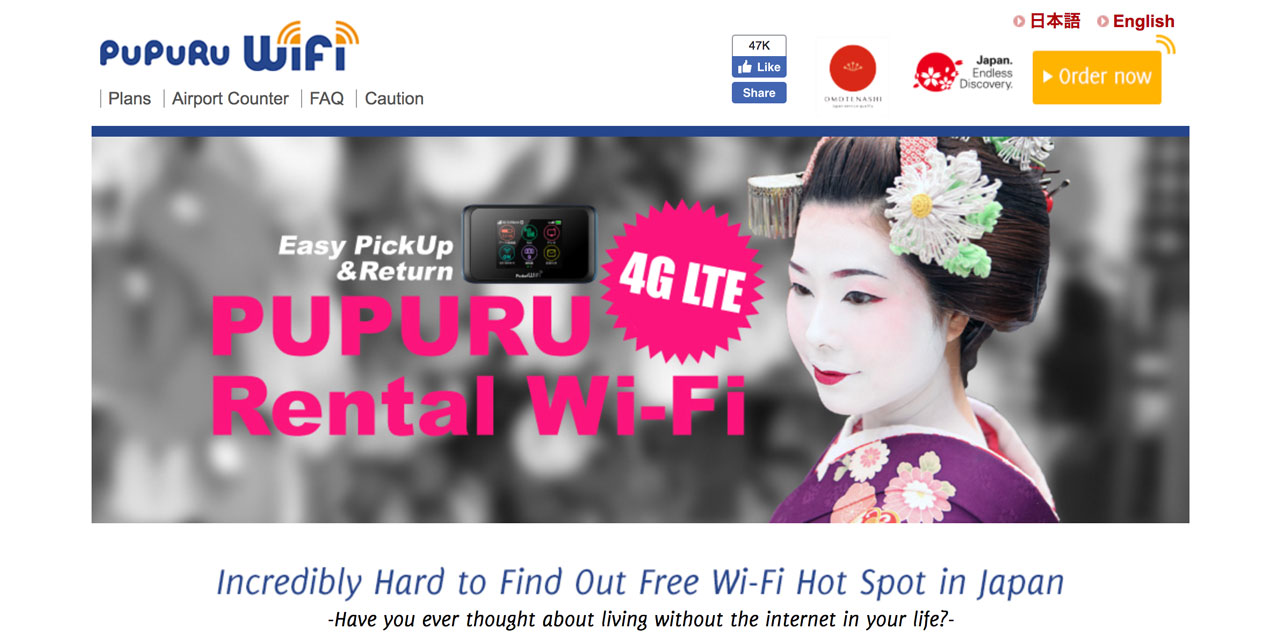
Pupuru is the best pocket Wi-Fi we've tried personally. The company offers two device/price plans: a "High Speed" option with unlimited data usage for ¥700/day, and a "Broad Coverage" option with unlimited data usage for ¥1,000/day. For both plans, there is a one-time ¥1,000 delivery charge.
The rental process is a breeze. Just reserve your device online (the Pupuru website is in English) using a credit card, and it will be waiting for you at a specific airport, hotel, or private residence in Japan. When you're done, just drop everything into the prepaid envelope provided and plunk it into a mailbox. There's one right outside security in Narita. Easy!
For our company trip to Japan, the Tofugu team used Pupuru pocket Wi-Fi. Despite being a little more expensive than some other Japanese-only rental options, its convenience more than made up for it. We barely noticed Pupuru working in the background, and that was a good thing!
Koichi’s Review
I usually use Pupuru when I go to Japan—recently, several times a year. No data caps, great customer service, and convenient delivery to anywhere are the reasons I keep coming back, despite being more expensive than some other options.
Pros
- Easy to reserve
- Can be picked up at the airport, your hotel, or delivered to a private residence
- Reliable speed
- Durable battery
- Hassle-free returns
- You can rent a Pocketalk translator device along with your hotspot.
Cons
- More expensive than many other options
Wifi Rental Dotcom (Wifiレンタルどっとこむ)

Wifi Rental Dotcom is a basic pocket Wi-Fi rental service, reasonably priced, with twelve options available. Our experience with the SoftBank 303ZT router was excellent, with easy pick-up and return, a durable battery (as long as we remembered to charge it each night), and quick page loading even in rural areas. The company's website and customer service was excellent… though it's all in Japanese.
Mami’s Review
Nothing to complain about from me. I got a great deal for a cheap price, and the customer service was good, too. The only slight downside is that they don’t have an English webpage, which is too bad.
Pros
- Lots of options and price plans. Like, a lot.
- Great customer support (if you can speak Japanese)
- Discount prices available if you shop around
Cons
- Only in Japanese
- Pricing is a bit confusing
Genki Mobile

Genki Mobile provided us with a free pocket Wi-Fi to try. For 1GB (per day), this pocket Wi-Fi will cost you ¥300 per day. For 2GB, it goes up to ¥500 per day. There's a third option for long-term stays of sixty days or more that will cost you ¥200 per day, though you're limited to 1GB. Like other pocket Wi-Fi services, exceeding your daily data limit will result in a 200kbps data cap (until the next day starts). This is certainly enough for the average tourist, but it won't hold up under heavy work or Netflix streaming.
Rental through the website is easy, and you can pick it up at the airport (just be sure to order it three days before you arrive). When you're done, drop the unit off in any Japanese mailbox using the included, pre-paid shipping envelope.
One notable difference between Genki Mobile and the other services we've used is the free battery and the pocket Wi-Fi's actual hardware and OS. In general, it felt a little less breakable and less prone to overheating. That said, it did require a proprietary charging cable (not the regular USB cable), which means one extra cord to carry. Not a huge issue, though.
Jamal’s Review
Everything worked as advertised, and the hardware was interesting. I had to be careful not to exceed my data cap, but with basic use I rarely got close. All-in-all, a decent option, especially if you’re staying in Japan long-term.
Pros
- Easy to reserve
- Can be picked up at the airport, your hotel, or delivered to a private residence
- Free external battery
- Hassle-free returns
- Hardware felt more durable than most
Cons
- Proprietary charging cable
- Speeds were acceptable, but never able to get download speeds as high as some of the others
Other Pocket Wi-Fi Options
Our research into pocket Wi-Fi rentals was diverse, but by no means exhaustive; in the future, we'll report back with reviews of more companies and products that we use ourselves. In the meantime, you may choose to check out some other options listed below.
JAL ABC
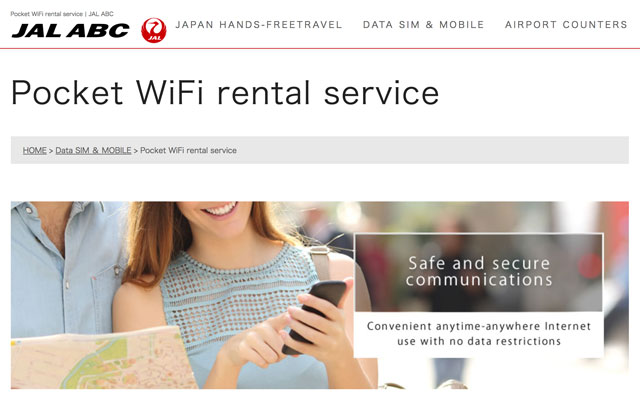
JAL offers two plans: the Wi-Fi router type (¥1,290/day) works as a normal hotspot; the USB option (¥980/day) works when plugged into a power source, like a laptop. Both plans have no data restrictions or additional fees; you can pick up and drop off at any of Japan's three major airports. JAL ABC is connected to Japan Airlines, and every ¥100 you spend earns you additional JAL miles (which are under the United/Delta umbrella).
You reserve your device in advance online or over the phone—if you reserve by phone, you have the option of delivery to wherever you're staying in Japan. If you're arriving at NRT, HND, or KIX, you can rent a device (with cash or card) without reserving it in advance. Drop-off is airport-only.
Pros
- Earn JAL miles
- Pick up and drop off at the three major airports
- Simple plans and pricing
- No reservation needed
Cons
- Drop-off at airport only
Japan Wireless
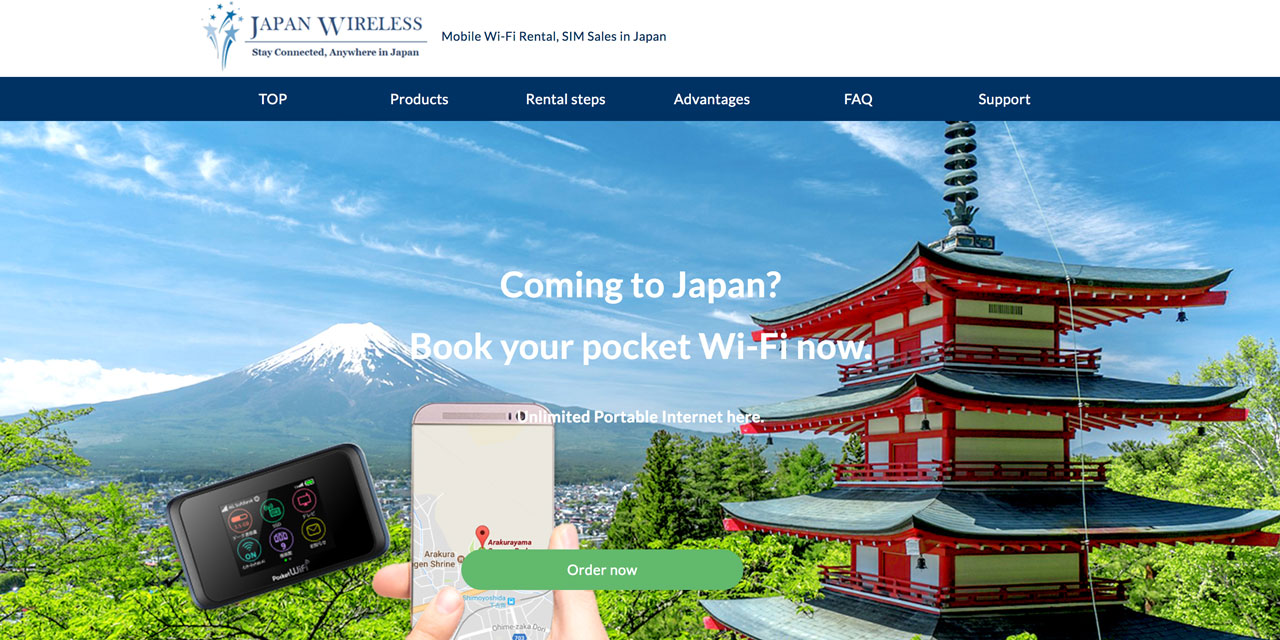
Japan Wireless offers a few unusual perks, the first of which is unlimited usage—no need to curb your streaming habits. A free mobile battery ensures you won't lose power at crucial moments, and a one-day shipping policy won't keep you waiting.
The company offers two types of devices, which makes shopping easy, though pricing is complicated. (Here's a chart explaining how it works. Basically, the longer you rent, the cheaper it gets. They offer insurance and SIM card options, too.
You can reserve your device online with a major credit card, and choose your delivery location. Unfortunately, there's no airport pick-up—you have to know where you're staying before you reserve. Like Pupuru, returns are done with a prepaid envelope.
Pros
- Unlimited usage
- Free mobile battery
- One-day shipping
- Easy returns
Cons
- Only two types of devices available
- Complicated pricing
Global Advanced Communications
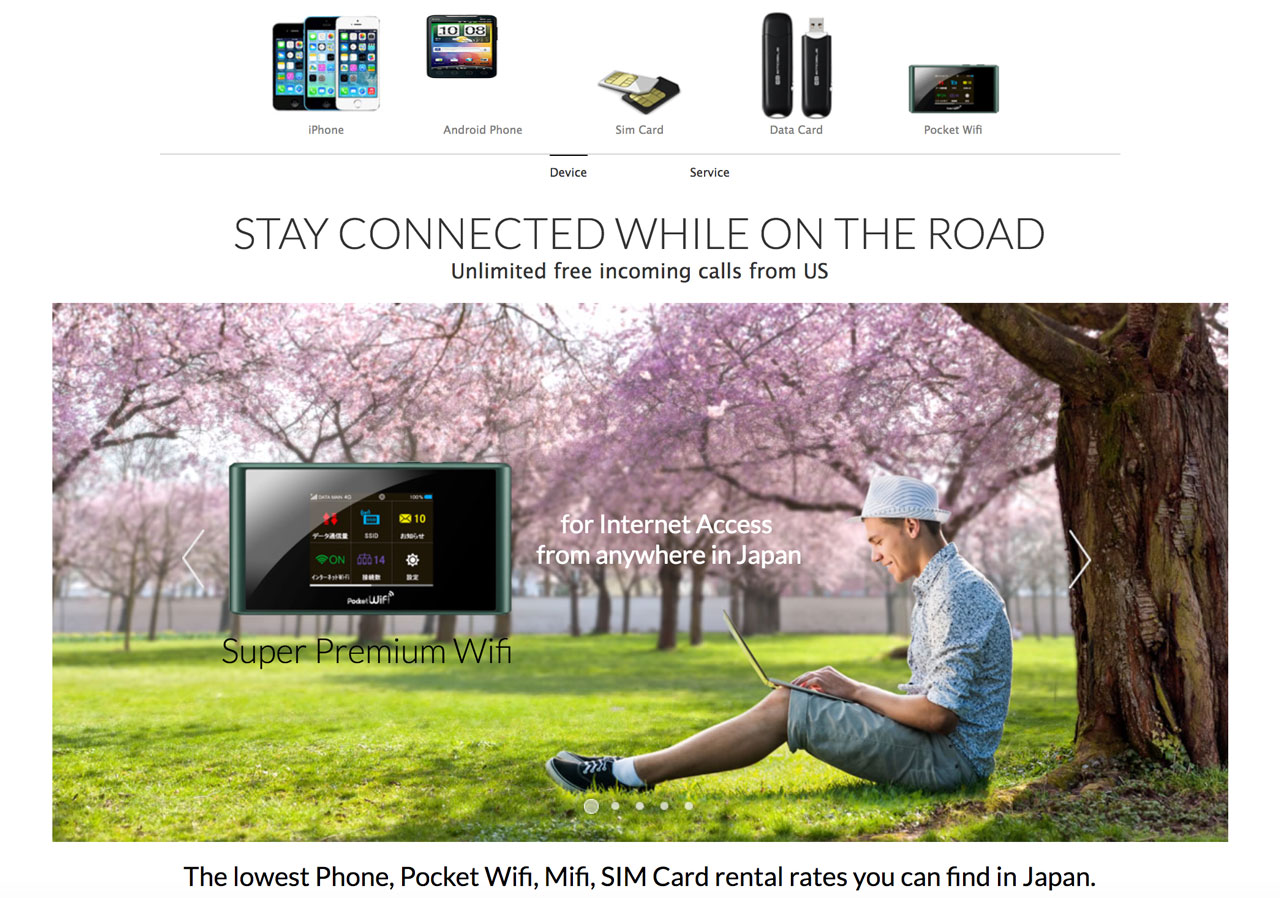
While Global Advanced offers the cheapest Wi-Fi hotspot in Japan, it's also problematic. Each of its four devices come with a different plan: Super Premium, a super fast model with wide coverage; Premium, with pretty fast speeds and wide coverage; Standard, with pretty fast speeds and no wide coverage; and the ECO, with slower speeds and no wide coverage.
Ordering and pricing are insanely complicated, and there seems to be no guarantee that they'll have the device you want when you want it. If it is available, the company will send payment instructions and info on the pick-up process.
The good news? GAC accepts major credit cards, and can send your hotspot anywhere in Japan—they also service six airports. Like Pupuru, returns are done by mail with a prepaid envelope.
The not-so-good news: even though their website advertises "unlimited Internet access," the Standard plan is limited to a 10GB data limit per month—almost impossible not to fill in a month's time. It's a terrible option. In the end, Global Advanced Communication may save you money, but you'll need to navigate a lot of fine print (and may need to curb your streaming habits) to do so.
Global Advanced Communications Website
Pros
- Return by mail
- Cheapest Wi-Fi hotspot rental in Japan
Cons
- Standard Wi-Fi: 10 GB limit per month
- Super complicated pricing
- No insurance option
Ninja Wifi
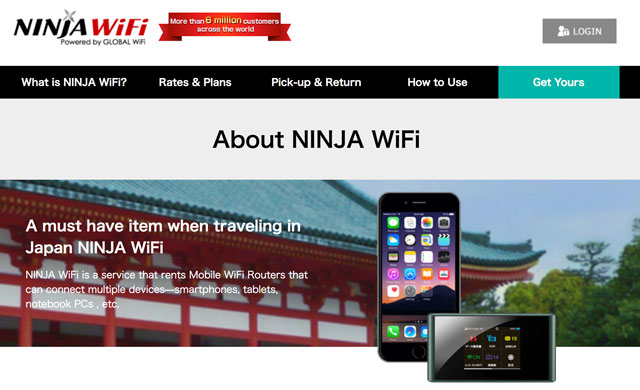
Ninja Wifi is the English-language-accessible version of Wifi Rental Dotcom (above). Unfortunately, the convenience of ordering in English results in higher prices than its Japanese counterparts.
If that doesn't bother you, Ninja is great. There's only one device, but it comes with all kinds of add-ons to choose from: a two-port car charger, external battery pack, Pocketalk translation device, and various insurance options. The company offers the most pick-up points of any hotspot rental service, with counters at every major Japanese airport (plus a ¥500 delivery fee).
Ninja's LTE coverage is 99% of Japan, and activation is a snap—just turn the device on and enter the password. You can order your hotspot up to one day before you need it (ギリギリ, as they say in Japanese), and the company accepts all major credit cards.
Pros
- Pick up and drop off at any airport
- 99% LTE coverage
- Easy activation
- Lots of options
- Option to order a Pocketalk translator device at the same time
Cons
- Higher prices than the Japanese equivalent
Japan Mobile Rental
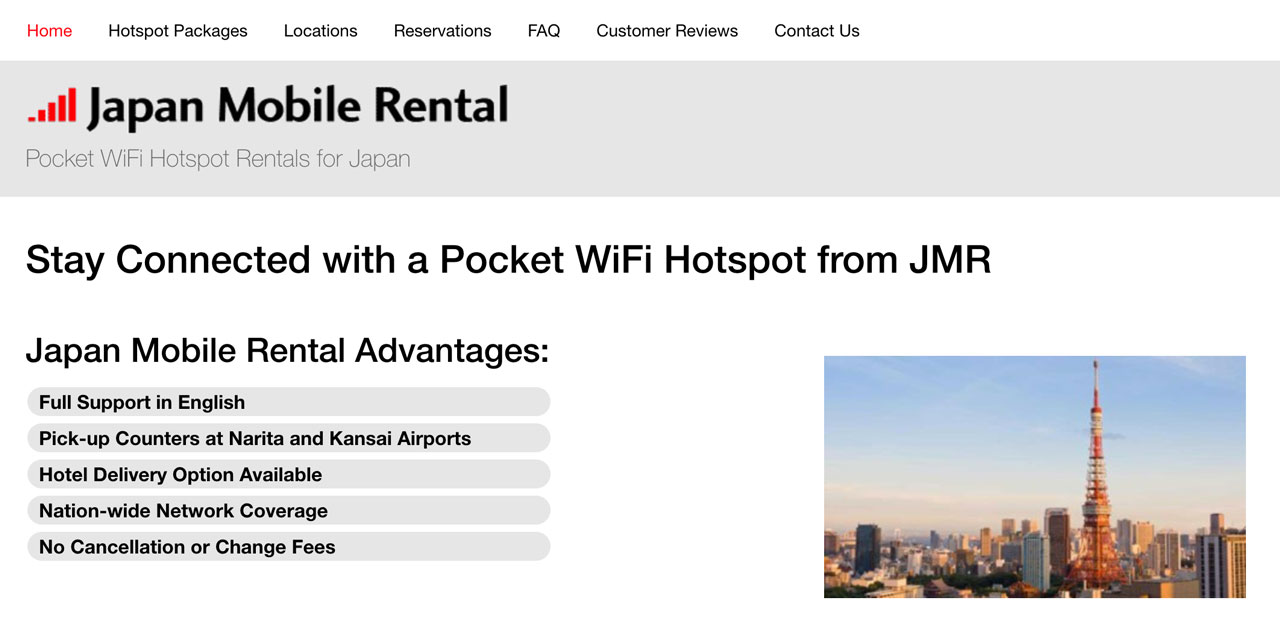
Japan Mobile Rental is a no-frills service (though not necessarily the cheapest), with full English support and nationwide network coverage. It offers two plans: a faster one with a data limit, and a slower one with unlimited data. It's a little complicated, though, because fees are based on usage, and include some upfront costs you should know about.
You can easily pick up your device at NRT or KIX; they offer hotel delivery options too, for a fee. There's also a non-refundable admin fee of ¥1,000, and a refundable ¥10,000 deposit. There are no cancellation fees.
The actual wireless Internet you get is serviceable, but nothing special. Although the Unlimited plan is slower, it's cheaper, and you'll never run out of data. The first week will cost you ¥1,200/day, after which the price drops to ¥580/day. It's fine for web basics, but "not suitable for streaming high resolution videos." (Isn't every video high res these days?)
The 4G Data plan is perfect for those who want fast speeds but don't mind having a cap on their daily and monthly data usage: up to 300MB/day with a cap of 7GB total for the month. Past these caps, it's ¥800/500MB downloaded. The daily rate is ¥1,500, but this drops to ¥1,200 after the first seven days.
Pros
- Pick up and drop off at NRT and KIX
- English support
Cons
- Admin fees and deposits
- Internet speeds are only good for light browsing
- Faster plan has caps on daily and monthly usage
Telecom Square
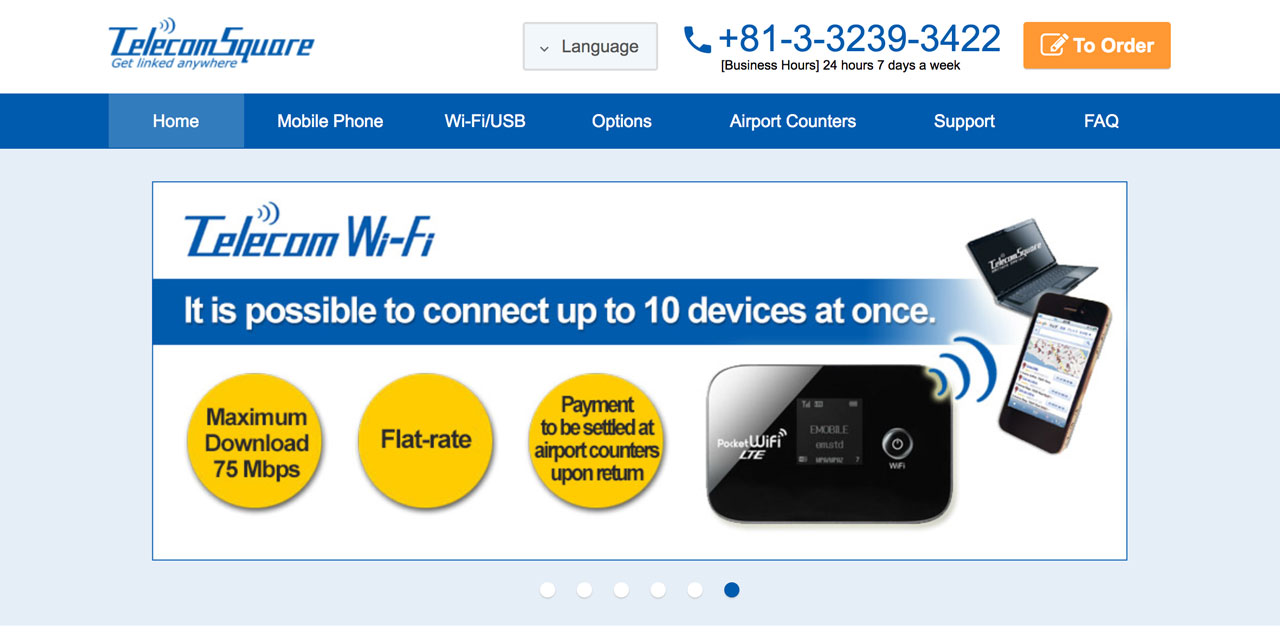
Longtime Japanese company Telecom Square offers two pocket Wi-Fi devices with a variety of payment plans. The "Wide Type," which can be used in rural areas, costs ¥1,512/day. (A longer-term Pack30 plan, which is ¥16,200/30 days, averages ¥540/day.) The "City Type" router is best in urban areas, but may not be reliable when you get out to the inaka. It's either ¥1,296/day, or you can choose from a variety of longer-use payment plans. (A Pack30 plan, for example, reduces fees to ¥432/day.)
Ordering online is easy: make your reservation by 5:00 p.m. the day before (for courier delivery, same time but two days before), and you can pick up (and drop off) at seven major airports. Telecom Square offers twenty-four-hour tech support and all kinds of optional add-ons, including mobile batteries and insurance plans. Payment is handled at the end of your rental period.
With Telecom, you can order at the airport counter without a reservation, and (depending on availability) pick it up right then. Good to know when you nab those super-cheap, two-days-before plane tickets!
Pros
- Reliable company with 24 years of service and over 500,000 people served per year
- Airport counters for pick-up and drop-off
- 24-hour tech support
- Optional insurance plans
- Can order same day from airport counters
Cons
- Confusing prices and options
Rakuten Wi-Fi Hotspots
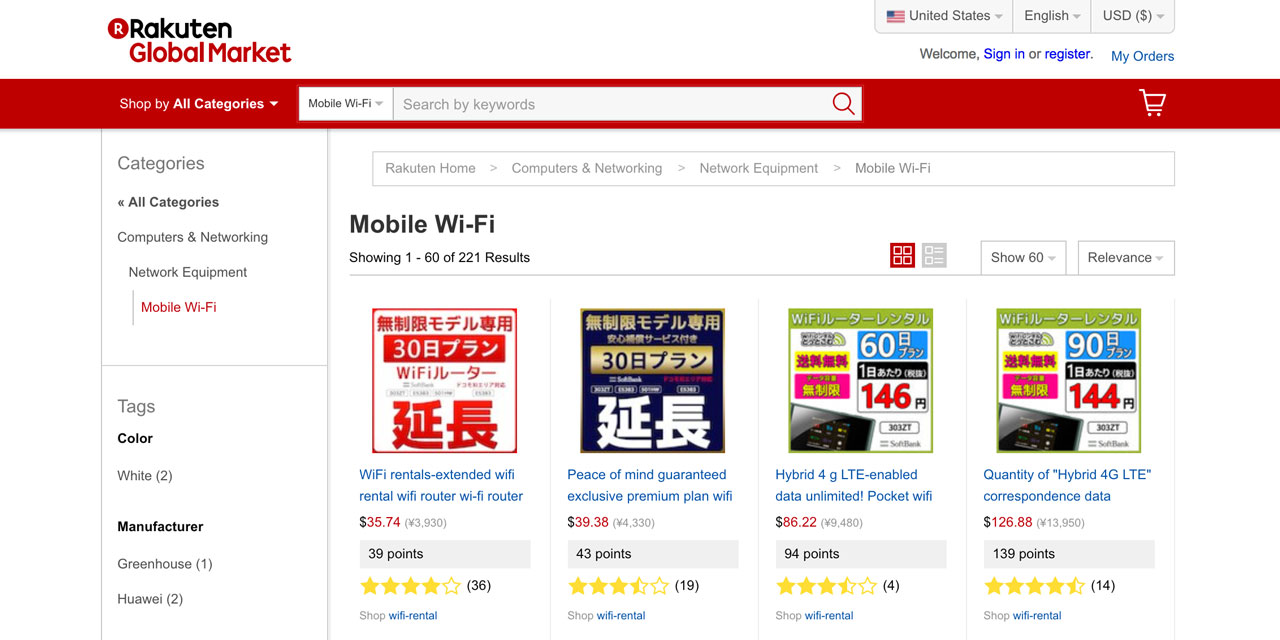
Technically, Rakuten isn't a Wi-Fi rental service. But Japan's answer to Amazon has made itself a hub for Japanese-only Wi-Fi hotspot rental service deals, which it translates into English. While Rakuten's offers will be much cheaper than any of the English sites listed above, the company's command of English may leave some details unclear. You'll find low prices, but spotty translations (or your understanding of them) may sign you up for something you didn't bargain for. Be careful!
Rakuten Wi-Fi Hotspots Website
Pros
- Rock bottom prices
Cons
- Unclear English translations
Using Your Phone in Japan

The lack of public Wi-Fi in Japan may not be an issue if you don't mind using data from your smartphone plan. If you prefer to use your phone, we have a couple of options for you (if you're from the US).
Project Fi
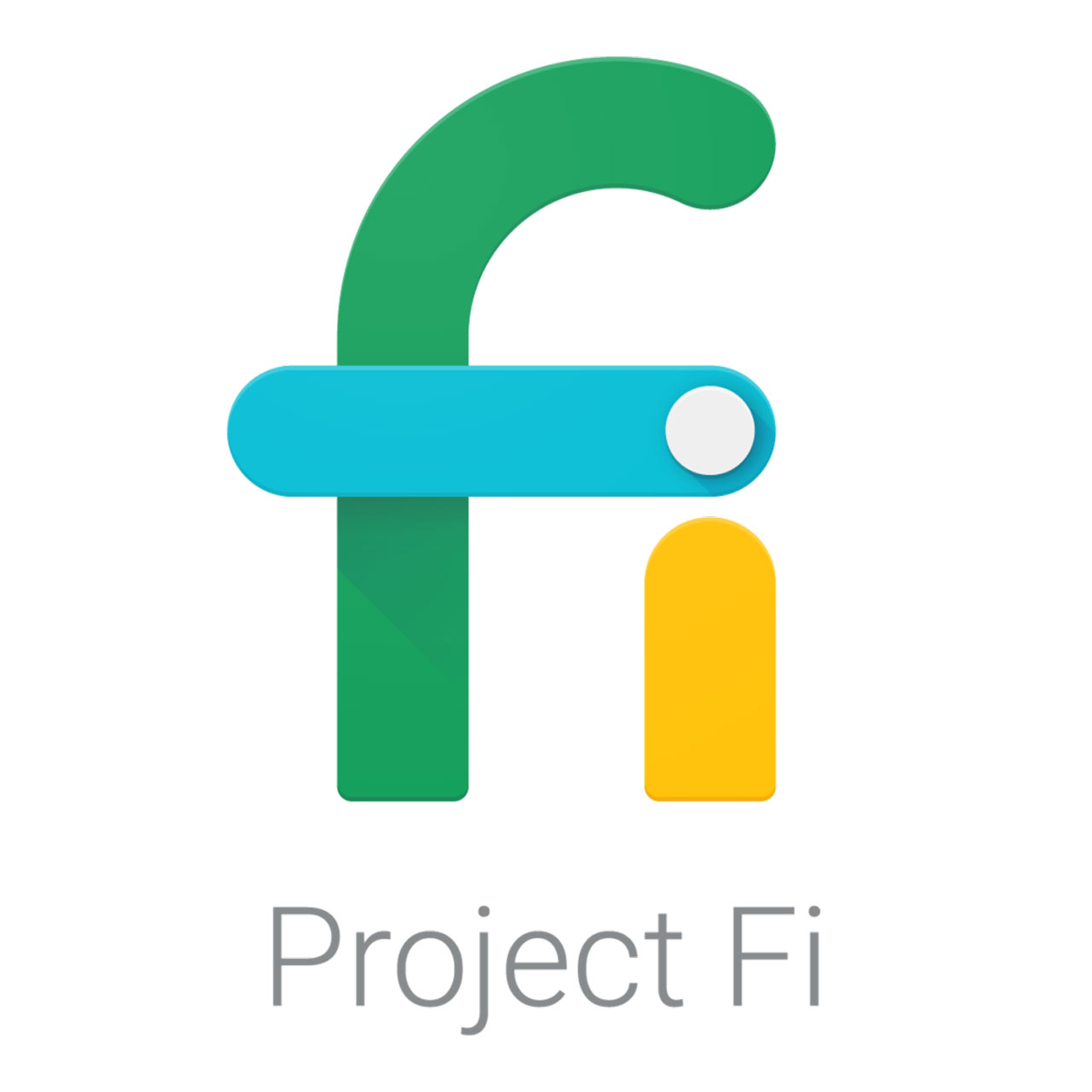
In the US, Google's Project Fi cell service piggybacks on Sprint, T-Mobile, and US Cellular towers, automatically switching to the fastest network or (if it's available) to open, trusted Wi-Fi. The service costs $20/month for unlimited talk and text; data costs $10/GB and tops out at $60—all data past 6GB is free.
For international travelers, the same terms apply: Project Fi offers domestic data rates for international usage, which means you get high-speed data in 170+ countries (including Japan) at no extra cost. The bottom line? With Project Fi, you can use your smartphone the same way you would in the US and suffer no penalties, overages, or unexpected fees.
The only catch? Project Fi works on only eight Android phones—you'll either need to own one already or buy one to use the service.
Michael’s Review
During my trips to Japan, I just use my phone the way I do in the US, which is never data-heavy—Google Maps and general Internet searching. I don’t download or stream anything over data, so my bill is usually pretty affordable. My bill after the trip to Japan was about same, maybe slightly more expensive.
The service was excellent, and I never experienced any slowdown or had any trouble connecting—and I was in some pretty rural areas. The best review I can give Project Fi is that I took my smartphone to Japan, used it as I normally would, and didn’t pay anything extra, or need a special SIM card.
Pros
- Surprisingly affordable for international phone data
- Easy access to 4G LTE
Cons
- Limited phone options
- You have to buy your phone outright
T-Mobile

T-Mobile currently offers unlimited international data and texting in 115 different countries. While this works well (and you can upgrade your data speed for a reasonable fee), the free international data plan is slow. Very slow. It's enough to check your email, send a message, and load a maps app (if you're willing to be patient). But don't plan on going through your news feeds or loading up Twitter.
Koichi’s Review
I use T-Mobile, and it’s been convenient to have free Internet access on my phone in Japan. It’s just fast enough to get by, and I actually like how it curbs my Internet usage. I read more books on the train, and enjoy ignoring my coworkers’ messages. That being said, I pretty much always just pay for a Wi-Fi hotspot, because there’s no way to get work done otherwise.
Pros
- Unlimited international data and text
- Available in 115 countries
Cons
- Free international data plan is slow
Logging Out
As we learn more about Wi-Fi options in Japan, and review more services and products, we'll update this page. Keep it handy.
For the modern traveler, Internet access has become just as important as access to electricity or running water. Your Tofugu friends know that reliability and value are important to you, so as we learn more about Wi-Fi options in Japan, and review more services and products, we'll update this page. Keep it handy.
Until then, please remember to plan ahead, read the terms of any agreement carefully, and let us know—via email or Twitter—if you've had really great or really terrible experiences with any of the options we've included here.
Until then, we wish you safe travels and smooth sailing (and surfing) on the Wi-Fi waves! 🥅 🏄
